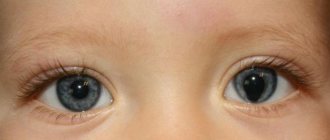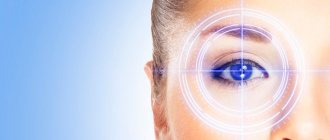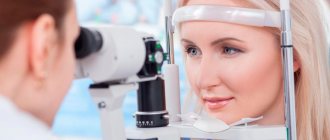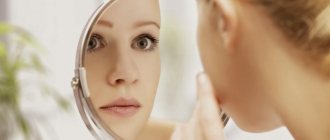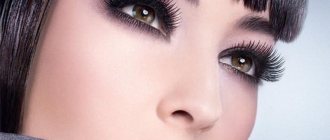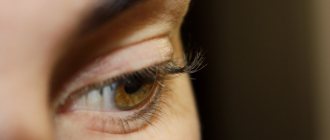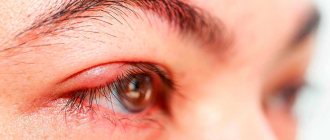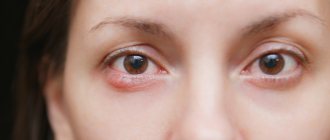Trichiasis is a condition in which there is abnormal growth of eyelashes, bending them towards the eyeball, which causes irritation of the organs of the visual system, damage to the cornea and conjunctiva. Eyelash removal is the main treatment for the disease.
Currently, work is underway on the website to change the price list; for current information, please call: 640-55-25 or leave a request, and an operator will contact you.
Prices for servicesServices
- Removal of eyelashes for trichiasis (1 eye) 270a
- Repeated appointment (examination, consultation) with an ophthalmologist 880a
The information and prices presented on the website are for reference only and do not constitute a public offer.
Definition of disease
Trichiasis of the eye is a pathology characterized by abnormal eyelash growth. In this case, they are directed not from the eyeball, but to the cornea. At the same time, the eyelid itself has its usual shape and does not curl up.
Not under all circumstances, abnormally growing hairs have the same shape, thickness, length and color. Most often, they have no shade at all and are very thin to the point of being impossible to detect without the help of magnifying optics and light.
The disease itself does not pose a serious threat to health, but it can cause other unpleasant pathologies.
ICD-10
Entropion and trichiasis of the eyelid - H02.0
Eyelashes may touch the eyeball, irritating it or the surrounding skin. This can lead to pain, redness, watering and damage to the cornea. Trichiasis can be caused by injury, inflammation, and certain eye diseases.
Like other ingrown hairs, eyelashes can become trapped under the skin and grow inward. This can lead to symptoms similar to those of eye diseases. It is important to correctly identify and treat the problem.
The eyelashes on the upper eyelid usually grow upward towards the forehead, allowing them to protect the eyes. Trichiasis causes the eyelashes to grow inward towards the eye. On the lower eyelid, where eyelashes usually grow downwards, with trichiasis they grow upward towards the eye. Trichiasis is more common in adults than children, but it can happen to anyone.
An ingrown eyelash can be mistaken for a stye, which looks like a pimple and usually goes away on its own within a few days. However, a person can easily differentiate a stye from trichiasis, which is characterized by a change in the direction of the eyelashes.
Trichiasis can occur in a few eyelashes, but it can gradually affect all eyelashes. Most people with trichiasis notice a specific area where many of the eyelashes grow in the wrong direction. The main problems of the patient with trichiasis
- eye irritation and other symptoms:
- sensation of a foreign body in the eye;
- redness around the eyes;
- increased sensitivity to light;
- watery eyes;
- itching or pain in the eye.
If left untreated, trichiasis can damage the eye, for example by causing infection.
When another eye condition causes trichiasis, there may be additional symptoms. A condition that often occurs with trichiasis is called blepharitis
. It is associated with inflammation of the eyelid margins, which become red and tender.
Injury
The scar that forms after the injury can cause eyelashes to grow in a different direction.
Eyelashes and hair follicles may change temporarily as the child grows.
Chronic blepharitis involves inflammation and irritation of the eyelids, which can cause redness of the eyelids.
This condition causes the eyelid to fold inward, which can lead to trichiasis. Age-related muscle and tissue weakness can cause entropy, as well as infection or injury.
Herpes can infect the lining of the eyes and damage the eyelids, causing trichiasis.
Trachoma is a severe infection of the eyelid that can affect the eyelashes and even cause blindness.
Trachoma Photo: Flickr/Community Eye Health
Eyelash hair removal methods
Mechanical hair removal usually refers to the first line, especially for a few isolated eyelashes. However, eyelashes typically grow back within a few weeks, and additional therapy is usually necessary if the eyelashes return. Electrolysis or electrolysis involves inserting a probe into each individual follicle under a slit lamp or the magnification of a working microscope. After the local anesthetic penetrates the eyelid, a probe is inserted along the hair shaft. An electrical charge is applied until bubbles are visible at the root of the hair shaft. If the hair shaft and bulb stretch freely, the treatment was successful.
This method has also proven to be quite effective for isolated follicles, but the procedure is very painful and can also lead to overgrowth and scarring of the eyelids. Radiofrequency hair removal is performed in much the same way and has been found to have a high success rate (56 to 90%) and cause less scarring than electrolysis.
The argon laser achieved similar success rates with limited side effects due to precise tissue destruction. It is an appropriate choice when the troublesome eyelashes are few and far between, and when they are not secondary to an inflammatory condition. The argon beam is usually titrated based on cilia pigmentation, with suggested laser settings ranging from 300 mW/0.5 s/50 µm to 1200 mW/0.2-0.5 s/50-100 µm.
Repeated burns are necessary to destroy the follicles. Reported success rates range from 45 to 62 percent after the first treatment and from 68 to 70 percent after two treatment sessions. Side effects are primarily short-term swelling and erythema (side effects are minimal compared to more destructive forms of eyelash hair removal).
Several recent studies have used an 810nm diode laser instead of argon, which works by using a contact probe to direct laser energy along the lash line. According to statistics, after laser hair removal there is a decrease in the growth of unnecessary eyelashes and a relapse is eliminated, as well as complications are minimized.
Cryotherapy is effective for large, confluent areas of trichiasis. After the local anesthetic is injected, the probe is applied to the treatment area using a bonding gel such as Surgilube.
Cold processing then begins, with thermocouples set at -20 to -30 degrees Celsius. The coupling is held for 5 seconds and then allowed time to defrost. This process is repeated, thus completing the double freeze-thaw method. Statistically, success rates range from 90 to 91 percent. However, the surrounding soft tissue is often affected, resulting in:
- entropy of eyelids;
- swelling of the eyelids;
- channel-like scarring;
- pigmentary changes in the eyelids.
Very extensive trichiasis can also be treated with surgery. Surgical techniques include eyelid wedge cutting, horizontal blepharotomy, and eyelid splitting. Surgical or radiosurgical lid margin splitting provides direct access to the eyelash follicles, which can then be effectively destroyed or extirpated internally using some of the above techniques. The method for eyelash hair removal procedure is determined by the doctor, taking into account the degree of manifestation of the disease, the patient’s condition and the risks.
An eyelash got into the eye, what should I do?
Eyelashes are constantly renewed - new ones grow in place of those that fall out. A person may not notice how a small hair has fallen out. It happens that it gets into the mucous membranes, causing some discomfort.
Eyelashes can break off and become trapped in the eye by growing in the wrong direction. The person feels a foreign body, notes redness of the mucous membrane, and increased sensitivity to bright light.
Eyelash extensions can get on the surface of the eye shell. It causes pain and stinging. Prolonged contact of the cornea with chemical reagents located on the surface of the eyelash causes a decrease in visual acuity, puffiness, and swelling.
What to do if it is too deep - on the mucous membrane? After all, improper removal can cause injury. To remove an eyelash, cover your eye. Gently stroke your eyelid in a circle with your finger. The eye then opens to find out where the eyelash is. If it remains on the mucous membrane, the procedure must be repeated until it leaves the mucous membrane. Then the eyelash should be removed with a sterile napkin.
If you have lenses on your eyes, they will have to be removed. There may be a hair stuck to the lens. If so, it will be easier to remove. Otherwise, you need to get the eyelash using the method described above. But the lens still needs to be washed in a container with a special solution before putting it back on.
If the effect is not achieved and the eyelash still remains in the eye, you can try rinsing it. To do this, water should be boiled and cooled to a comfortable temperature. Then it is poured into a container. You need to immerse your face in this vessel, and then try to blink. Having raised your face from the water, you should blink a couple of times again. If it does not help, the procedure can be repeated. In any case, an eyelash in the eye is not a big deal. You just need to learn how to remove it correctly to avoid possible complications.
In the next article: itching in the corners of the eyes
Types and classification
Trichiasis can be classified according to its types and causes. The following types of disease are known:
- Districhiasis (characterized by the presence of two extra rows of eyelashes growing in the wrong direction);
- Unilateral and bilateral (only on one eye or both at once);
- Distichiasis (has an extra row of eyelashes);
Distichiasis
- Madarosis (full row of eyelashes or partial damage);
- Local;
- Common.
Also, all forms of the disease can be divided into:
- Idiopathic;
- As a complication of blepharitis;
- Scar.
Types of blepharitis
There are several types of disease:
- Simple or scaly blepharitis (seborrhea) . It is characterized by redness and thickening of the eyelids, itching, narrowing of the palpebral fissure, and photophobia. At the base of the eyelashes you can see yellow or white scales, very similar to dandruff. The skin under the scales is red, and sometimes blood vessels can be seen. The eyelids are very itchy. Sensitivity to light is very high, and there is also an increased reaction to wind and dust. By evening, my eyes get very tired. If there is no treatment for a long time, blepharitis can last a very long time.
- Ulcerative blepharitis . The most severe form of the disease with severe pain develops most often at a young age. On the edges of the eyelids, it is not scales that form, but crusts with bleeding ulcers. Along with the crusts, the eyelashes also fall off, and pus is released from the hole. New eyelashes may grow in the wrong direction, causing baldness. In rare cases, scars develop on the eyelids or entropion occurs. Without appropriate treatment, the inflammatory process can move to the conjunctiva and cornea.
- Meibomian blepharitis . The meibomian glands, which are located deep in the cartilage of the eyelids, become inflamed. When pressed on them, a yellowish liquid is released. Purulent discharge can be observed in the corners of the eyes. The disease can occur in combination with conjunctivitis.
- Demodectic blepharitis . The reason is the demodex mite, which lives in the eyelash bulbs. It is present in every person and manifests itself in favorable conditions, for example, when immunity decreases. Symptoms of the variety are severe itching, especially after sleep. There is discharge from the eyes and you want to scratch your eyes. Gradually the eyelids thicken, becoming red. White flakes appear at the base of the eyelashes, looking like a muff or collar.
- Allergic blepharitis . Often combined with conjunctivitis. The reason is increased sensitivity to any medications, cosmetology products or perfumes. Also, an allergic reaction occurs due to contact with pollen, dust, wool, fluff, and household chemicals. Suddenly the eyelids swell, tears flow, the eyes hurt, the eyelids itch and it hurts to look at the light. Most often, both eyes are affected. The chronic form is characterized by unbearable itching of the eyelids. Exacerbations most often occur during the flowering period.
Based on anatomical characteristics, the following types of blepharitis are distinguished:
- anterior marginal - only the eyelash growth area is affected;
- posterior marginal - inflammation of the meibomian glands, leading to inflammation of the cornea and conjunctiva;
- angular - inflammation of the corners of the eyes with the accumulation of purulent discharge in them and thickening of the eyelids, the appearance of ulcers.
Why do some people's eyelashes grow in two rows?
The reason for this phenomenon among girls and men (yes, they are no exception) is distichiasis. Sounds like a pretty scary diagnosis. And it’s not surprising, because this is a mutation - a double row of eyelashes. Scientifically speaking, human eyelashes appear in two rows as a result of a transcription error on the sixteenth chromosome.
Photos of people's double rows of eyelashes can be both beautiful and terrifying. What else do you need to know about this?
Causes
As a rule, trichiasis is not a self-occurring disease. It usually appears as a complication of inflammatory pathologies of the organs of vision:
- Conjunctivitis of various forms;
Types of conjunctivitis
- Blepharitis;
- Injuries and mechanical damage to tissues;
- Burns from chemicals.
As a result of these lesions, hair follicles are destroyed or change their direction. Scars after healing can have the same unpleasant properties.
Incorrect treatment may increase the risk of developing trichiasis. In rare cases, surgery can cause eyelashes to grow abnormally.
Surgical intervention
The first treatment option for distichiasis is surgery. The person's eyelid is first frozen so that the procedure does not cause discomfort. After which the part of the mucosa that was affected by the mutation is removed. This method is very scary. Lots of people get trembled at the thought of a surgeon cutting or otherwise digging into their eyes. Truly a frightening process. Luckily, there are other ways to remove the second row of eyelashes.
Symptoms
Visible signs of trichiasis of different types are not always visible to the naked eye. However, the patient may experience the following symptoms:
- Painful sensations;
- Feeling of a foreign body under the eyelid;
- Excessive lacrimation, lacrimation;
- Fear of light;
- Redness;
- Rapid fatigue of the visual apparatus;
- Itching, burning.
Constant pain, frequent blinking and tension can contribute to constant fatigue and headaches.
Is it harmful to leave an eyelash in the eye?
Even a small foreign body causes damage to the cornea. The consequences of mechanical irritation of the eye are different. With a mild degree of the pathological process, a person feels discomfort in the area of the organ of vision and tingling. In severe cases, severe degenerative and infectious processes develop.
Self-medication is especially dangerous. Instillation of anti-inflammatory or antibacterial drops causes serious damage to the cornea, which can lead to visual impairment.
To avoid the development of inflammation, you should not leave the eyelash in the hope that it will go away on its own. It can get deep under the eyelid and become infected, causing serious illness. The most dangerous for the organ of vision:
- infectious conjunctivitis – inflammation of the conjunctival sac;
- blepharitis - inflammation of the edge of the eyelids;
- neuritis of the optic nerve (leads to a sharp decrease in visual acuity, impaired color perception, narrowing of the boundaries of the visual field);
- endophthalmitis (purulent inflammation of the internal membranes of the organ of vision);
- iridocyclitis (inflammation of the iris).
- panophthalmitis (purulent inflammation affecting all membranes of the eye).
Panophthalmitis
The consequences of getting an eyelash into the eye can be significant. If the eyeball is damaged or the cornea is damaged, vision may deteriorate. Even a slight defect in a natural lens will lead to a violation of its transparency and the possible appearance of a spot on the pupil.
When an eyelash gets into the eye and remains there, the person will constantly have the uncomfortable feeling of a foreign body in the cavity. Over time, if you do not take measures, do not try to remove the foreign object, the pain will intensify, profuse mucous secretion will begin, redness of the eye will occur, and inflammatory processes will occur, which can even lead to loss of vision in the worst case.
There are many ways to extract eyelashes on your own, however, if all of these methods do not help, then you should definitely seek help from a specialist.
On a note. An ophthalmologist directly deals with problems with the eye cavity, but in some cases a consultation with an infectious disease specialist, dermatologist, plastic surgeon and cosmetologist may be prescribed.
Rehabilitation period and the possibility of complications after treatment
It is present even when the intervention was not too painful. The rehabilitation period after treatment of distichiasis lasts two weeks. At this time, the patient continues to take the prescribed pills, antibiotics and uses special eye drops that help protect the cornea from environmental influences.
As for the possibility of complications after treatment of distichiasis, there is practically none. In approximately ninety-seven percent of cases, if the patient followed all the recommendations of his attending physician and did not neglect the rehabilitation period, the treatment will indeed be successful. If the patient does not take all the advice seriously, then corneal erosion, inflammation of the eye, conjunctivitis, and visual impairment may occur.
Possible complications
Timely treatment of trichiasis is necessary, since the disease can cause frequent inflammatory processes (including purulent ones) and contribute to the development of infections and other lesions. Among the most severe consequences of lack of proper treatment:
- Changes and deformations of the lacrimal gland, improper outflow of fluid;
- Permanent traumatic damage to the membrane of the eyeball;
- Constant fatigue;
- Photophobia;
- Corneal ulcers;
- Blepharospasms.
Due to the progression of the disease, a person loses the ability to lead a normal lifestyle, cannot work normally, and loses the ability to painlessly open and close his eyes. The hygiene of the visual apparatus is also difficult and the appearance changes for the worse.
Treatment should begin immediately after the first symptoms appear.
Clinical picture
An eyelash can grow into both the skin of the upper eyelid and the eye tissue. Sometimes a lost eyelash gets caught in the lacrimal gland, which causes the sensation of a foreign body in the eye.
When an eyelash grows into the skin of the upper eyelid, one can observe the formation of an epithelial tubercle through which the eyelash is visible.
If the eyelashes change the direction of growth towards the eyeball, then when blinking they irritate the cornea, leading to erosion formations. Patients often develop photophobia and blepharospasm. This condition causes frequent blinking, which complicates the situation.
The degree of corneal injury depends on several factors:
- Number of ingrown eyelashes;
- Duration of the pathological process.
As a result of injury to the cornea, infection of the eye tissues, development of superficial keratitis and clouding of the cornea can occur.
Trichiasis can be local, when ingrowth of a limited number of eyelashes (1-2) is detected, or widespread. Most often, widespread trichiasis develops after an injury, which results in the formation of scars on the tissues of the eyelid or its inversion.
Symptoms
The main symptom of trichiasis is abnormal eyelash growth. The hairs grow into the lacrimal gland, causing its functionality to be impaired. There is a constant excessive secretion of tear fluid. If eyelashes grow into the upper or lower eyelid, then a person has the sensation of a foreign object in the eye.
The eyelashes stick out, and when the patient closes his eyes, they injure the skin and mucous membrane, on which small ulcers appear over time. In bright light, the patient experiences severe pain, and the eye muscles reflexively contract.
The severity of symptoms depends on the number of ingrown hairs and the duration of the disease.
Depending on the degree of prevalence, trichiasis is divided into 2 types:
- local - inflammation in which 1-2 eyelashes have grown into the eyelid;
- generalized (widespread) – massive damage to the entire eyelid.
The cornea is constantly irritated, red, and in some cases even bleeds. The patient blinks frequently and closes his eyes, which further irritates the cornea.
This disease is most often observed in older people.
Treatment
Therapy for this disease is quite possible today. In this case, the choice of method usually depends on the stage of development of the problem and on the diagnostic results. The study of the visual apparatus, in turn, includes:
- Study of visual acuity;
Determination of visual acuity
- Initial examination of the eyeball and eyelids;
- Biomicroscopy to study the harm of contact of the ciliary surface with mucous membranes and the cornea;
- Elimination of possible inversion of the eyelids.
By medication
It is impossible to change the direction of eyelash growth with the help of medications. However, they can be indispensable for the prevention and treatment of inflammatory processes associated with trichiasis, as well as relieving its symptoms. Among the main medications prescribed by ophthalmologists is Levomycetin in the form of drops and eye ointment. Auxiliary products can also be used to relieve redness and swelling, and treat corneal ulcers.
Levomycetin – antibacterial drops
Surgically
Surgical treatment of trichiasis is the main method today. The most commonly used radical method is hair removal using electric devices and lasers. If they do not help and the hairs continue to grow incorrectly, surgery may be indicated, during which the affected area of skin is removed followed by transplantation of healthy donor tissue. It is also possible to transplant hair follicles to form a new healthy eyelash space.
Laser hair removal
The operation is usually performed under local anesthesia and often requires stitches and a sterile dressing that needs to be changed as needed. In addition, after it, antibacterial drugs are often prescribed to prevent infectious and other types of infections. If some time after the intervention the hairs grow back, they are cauterized on an outpatient basis using a laser.
During the postoperative period, it is very important to follow all doctor’s instructions and maintain hygiene and rest. It is important to change the bandage in a timely manner and not remove it unless absolutely necessary.
Folk remedies
There are no folk recipes for changing the direction of hair growth, but their use is often appropriate to relieve inflammatory processes and facilitate healing. Herbal medicine is usually recommended using a mixture of blue cornflower, calendula and linden, which must be taken in equal proportions. Use about half a glass of boiling water per teaspoon of the mixture. After cooling, the infusion must be filtered and used to prepare lotions.
Preventive measures against ingrown eyelashes
In order to prevent ingrown eyelash hairs, you should adhere to some rules, including:
- daily hygiene - morning washing, removing makeup with hypoallergenic products, prohibiting touching your eyes with dirty hands;
- compliance with the rules for using contact lenses;
- timely elimination of disturbances in the functioning of the visual apparatus (infections, increased tearing, bacterial pathologies, pimples on the eyelids);
- general strengthening of the immune system;
- undergoing a preventive examination by an ophthalmologist at least once a year.
To effectively and quickly treat eyelashes that have grown into the upper eyelid, you must follow the recommendations of your doctor. You should stop trying to remove ingrown hairs on your own to avoid complications and infection of the eyelids.
The constant sensation of a foreign object in the eye, pain from bright light, frequent blinking and tearing can be the cause of improper eyelash growth. Doctors call this disease trichiasis.
It is better to start treatment of trichiasis as early as possible so as not to get advanced forms of the disease, in which ulcerations appear on the cornea of the eye. They will be difficult to cure.
The inversion of the ciliary edge into the eye, in which the eyelashes grow towards the cornea, is called “ocular trichiasis”. This condition is different from entropion, which often occurs in older people. Here the eyelashes grow towards the cornea with the normal position of the eyelid itself. Trichiasis is included in ICD-10 (international classification of diseases), and according to it has code H 02.2.
There are several types of ocular trichiasis. Complete, when the entire ciliary row is located to the cornea or partial, with only individual hairs growing inward. Bilateral (on both eyes) or unilateral (on one, respectively). Distichiasis is the presence of an additional row of eyelashes growing towards the eyeball. The presence of two additional ciliary rows (very rare) is called districhiasis.
With trichiasis, abnormal hairs do not always have the usual thickness and color. Most often they are very thin and colorless. It is not easy to notice them with the naked eye in a mirror; sometimes ophthalmologists cannot see them with a slight magnification of the slit lamp during an examination. This requires both a high-magnification lamp and additional tests and examinations, including biomicroscopy of the edges of the eyelashes and cornea. Doctors note that trichiasis occurs quite often and is not a rare exception.
Diagnosis of trichiasis
Diagnosis of the disease begins with interviewing the patient and collecting anamnesis. It is necessary to clarify the genetic predisposition to the disease. Previous presence of burns, injuries and chronic inflammatory processes of the eyes.
Then a physical examination is performed:
- determination of visual acuity;
- external inspection;
- biomicroscopy of the direction of eyelash growth and the condition of the eyelid edges;
- identifying contact of eyelashes with the cornea and conjunctiva;
- determination of the condition of the cornea;
- biomicroscopy of the corneal conjunctiva using dyes.
A differential diagnosis of trichiasis with entropion and distichiasis is carried out. Madarosis is differentiated from marginal coloboma of the eyelid.
Prevention
Trichiasis does not have a congenital form, so its prevention is quite possible and even necessary in some cases. The following measures may be effective:
- Systematic observance of personal hygiene rules;
- Timely treatment of diseases of the organs of vision;
- Eyelash care;
- Avoiding traumatic situations and eye damage.
If a patient is undergoing eye surgery, they must carefully select a surgeon who can perform the procedure and apply stitches correctly. In this way, the risk of trichiasis can be avoided.
Clinical picture and treatment methods for entropion
Entropion or entropion is an ophthalmological disease in which the lower eyelid turns inwards. Along the edge of the anterior surface of the lower eyelid there are sebaceous glands and eyelashes, which, when turning the eyelid, come into contact with the conjunctiva of the eyeball and the cornea. Such constant contact is a mechanical irritation and damage to the eye, resulting in a characteristic clinical picture, and the function of the eye can significantly deteriorate, up to complete loss of vision. The only effective treatment for entropion is surgery.
Turn of the century:
- etiology of entropion: main causes;
- characteristic clinical picture of entropion;
- effective methods for treating entropion.
Etiology of entropion: main causes;
The following reasons can lead to the occurrence of such a pathological condition as entropion:
- congenital pathology - occurs in utero, as a result of impaired development of the eyeball and facial muscles;
- age-related changes - with age, the facial muscles that hold the eyelid in its normal position lose their tone, and the skin stretches. As a result, the eyelid may take on a pathological position in the form of an inversion. In this case, pathology is usually observed on both eyelids;
- cicatricial changes in the skin that occur after previous injuries in the eye area can lead to entropion of the eyelid;
- neoplasms in the eye area are also one of the causes of pathology. In this case, an entropion is formed as a result of the germination of eyelid tissues by tumor cells.
Symptoms - how eyelash deviation manifests itself
Due to the incorrect position of the eyelashes, trichiasis causes constant inflammation of the eyeball, which manifests itself with symptoms such as:
- Sharp and intense pain.
- Feeling of discomfort and foreign body.
- Severe irritation with redness of the eyes.
If trichiasis is not treated promptly, it can lead to serious consequences, including :
- Scar formation at the level of the eyeball.
- Formation of ulcers at the level of the cornea.
- Complete and irreversible blindness.
Causes of abnormal eyelash placement
The causes of trichiasis come down to a set of pathological eye conditions , among which are:
- Inflammatory conjunctivitis that occurs from the sun, wind, cold or the influence of foreign objects.
- Infectious conjunctivitis, that is, a bacterial, fungal or viral infection of the eyes.
- Blepharitis, i.e. an inflammatory process of an infectious nature on the eyelids.
- Physical injuries to the eyes resulting from an accident or eye surgery.
- Keratoconjunctivitis, i.e. simultaneous inflammation of the conjunctiva and cornea.
- Scar pemphigoid, an autoimmune condition that causes scarring of the mucous membrane.
- Eye damage and inflammation caused by contact with chemicals.
- Stevens-Johnson syndrome is an acute hypersensitivity reaction (similar to a severe allergic reaction) caused by an adverse reaction to medications or viral or bacterial infections.
- Epiblepharon, i.e. a congenital pathology of the eyelids, which causes the eyelashes to bend inward of the eye, but unlike classic trichiasis, the eyelashes grow beyond the edges of the eyelids.
- Distichasia, i.e. the presence of a number of extra eyelashes due to congenital reasons.
- Trachoma, an infectious disease of the conjunctiva caused by the microorganism Chlamydia Trachomatis.
Advice from experienced cosmetologists
Multiple rows of eyelashes are a rare feature. If they grow in the same direction, they give their owner a luxurious, eye-catching look. You can achieve this effect in different ways:
- use of mascara;
- contour tinting;
- eyelash extensions.
Extensions will add volume, length and give your eyelashes a seductive curve. There are three main techniques: eyelash, tape, beam.
Extensions will allow you to become the owner of fluffy eyelashes
The extension specialist can choose different volumes: two-, three- and four-dimensional. Different options are available to adjust the shape of the eyes: cat, squirrel or fox effect.
There are natural and artificial eyelashes on sale that can be used at home. Individual bundles or a whole series are available for purchase. In order to fix the hairs, you should purchase a special ophthalmic glue, the use of which will not harm the eyes. Bunches can be used every day. For example, adding them along the edges for a seductive look. Ribbon-type hair is more suitable for creating a festive and wedding look.
When you contact a specialist, you can perform extensions that will last up to one and a half months. After the expiration of the period, a correction is made. This look weakens natural eyelashes. For this reason, breaks should be taken from time to time, which can range from several weeks to several months.
Ingrown eyelashes into the upper eyelid
Many people do not even suspect that the eyelash has entered the eye cavity, because it has grown into the upper eyelid and does not cause noticeable discomfort: only a small bump may be observed. In some cases, it begins to fester and a boil forms. All this is subsequently accompanied by swelling of the eyelid tissue, the appearance of a reddish tint of the skin around the eye, and the formation of a purulent head.
When contacting a specialist, the doctor first asks the patient whether he has suffered from various eye diseases in the past. An external examination of the eyelids is carried out and visual acuity is checked.
On a note. An experienced specialist can always identify an ingrown eyelash during examination, after which the patient is prescribed biomicroscopy of the eye - examination of its cavity under a strong light source (slit lamp).
Dangers of buildup
When applying eyelash extensions, it is recommended to contact only experienced specialists. A master without enough practice can cause the following complications:
- the time of wearing eyelashes is reduced;
- inflammatory eye infections occur;
- an incorrectly chosen extension effect worsens the appearance;
- In the absence of a sample, an allergy may occur.
In order not to suffer from the consequences of extensions, you need to carefully choose a lash maker, study customer reviews, monitor the sterility of the procedure, and inquire about the expiration date of the materials used.
Two rows of eyelashes is a disease that can lead to serious complications. A small number of people on the planet have this feature. In addition, the pathology can be inherited. If the hairs do not cause discomfort, then there is no need to treat the anomaly. Otherwise, you should immediately consult a doctor who will prescribe the necessary treatment.
Who is Elizabeth Taylor
A luxurious figure without the gym!
Fitness expanders will allow you to organize a complete and effective workout both at home and on the street. You can achieve the desired result by doing just 20 minutes a day! Suitable for both beginners and trainers!
MORE >>
Elizabeth Taylor is an Anglo-American actress of the last century, whose appearance was admired by all men. She was an enigmatic legend, a talented and beautiful “Queen of Hollywood.” Most women envied her beauty and uniqueness, many tried to imitate and be like her. Elizabeth was an object of admiration, a standard of beauty. The most important mystery was hidden in the look of the actress - a goddess, and her thick dark eyelashes and rich eye color kept the secret for many years.
How dangerous is such a mutation?
Hypoallergenic mascara
On the one hand, such an unusual disruption of the body’s activity is a reward for the fair sex. Girls with this pathology do not need to use mascara, eyeliner or pencil to highlight the eyelashes and their contour. There is another category of people suffering from distichiasis. She experiences discomfort due to hairs getting into the mucous membrane. In this case, eye tics, corneal ulcers, pain, secretion and tearing may begin. An ophthalmologist can remove the extra row of eyelashes, but they will grow back in 7-10 days.
In addition to the double row, there are pathologies with a triple and quadruple row. They are called tristichiasis and tetrastichiasis.

